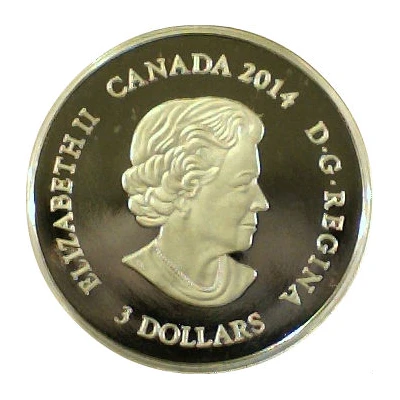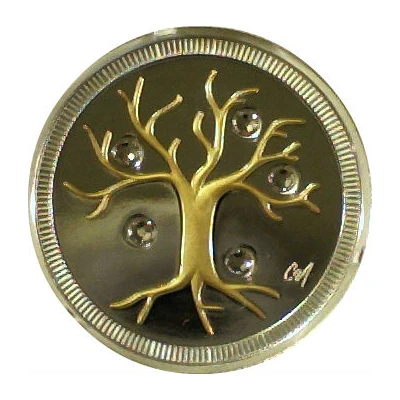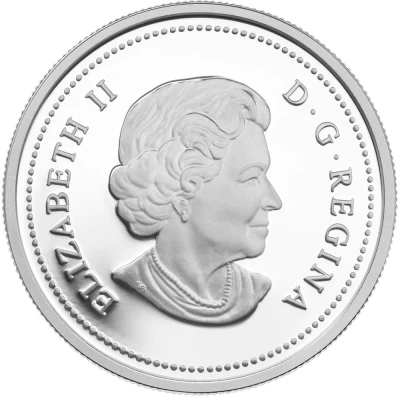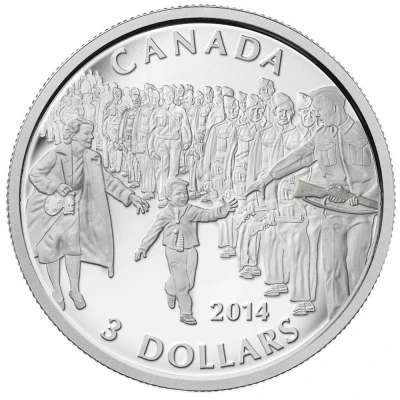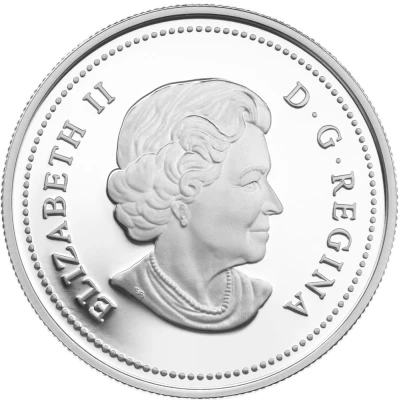
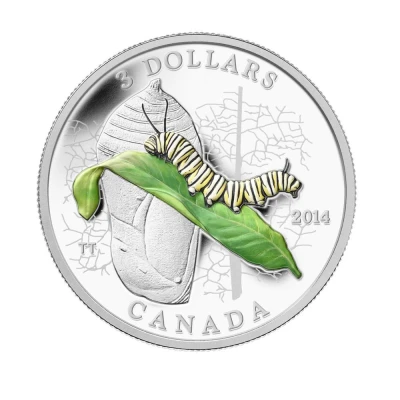

© The Coin Shoppe
3 Dollars - Elizabeth II Caterpillar and Chrysalis
2014 year| Silver (.9999) | 7.96 g | 27 mm |
| Issuer | Canada |
|---|---|
| Queen | Elizabeth II (1952-2022) |
| Type | Non-circulating coin |
| Year | 2014 |
| Value | 3 Dollars 3 CAD = USD 2.22 |
| Currency | Dollar (1858-date) |
| Composition | Silver (.9999) |
| Weight | 7.96 g |
| Diameter | 27 mm |
| Thickness | 2 mm |
| Shape | Round |
| Technique | Milled, Coloured (Painted) |
| Orientation | Medal alignment ↑↑ |
| Updated | 2024-10-04 |
| Numista | N#366041 |
|---|---|
| Rarity index | 93% |
Reverse
Caterpillar in color with Chrysalis in background.
Script: Latin
Lettering:
3 DOLLARS
2014
TT
CANADA
Designer: Trevor Tennant
Edge
Serrated
Comment
Third and final coin in the beautiful series of animal architects.Few metamorphoses are as dramatic as the one experienced bythe Monarch butterfly (Danaus plexippus), which are a welcome sight during the summer across the many regions of Canada. Its beautifully patterned black and orange wings easily make the species one of the most recognisable butterflies found in North America; however, this iconic form isonly attained during the final stage of its life cycle, after it sheds its brightly striped caterpillar form and develops within the safety of the chrysalis that encases it.
The process begins when the caterpillar spins a silk pad on the underside of a milkweed (Asclepias) leaf and attaches its hind claspersto it. Now suspended with its head facing downwards, the caterpillar's life depends on the strength of this attachment. Twisting around, the caterpillar sheds its skin to reveal a moist exoskeleton that hardens to a waxy, green-coloured coating. The chrysalis darkens and becomes transparent over the course of nine to 15 days, during which time the pupadevelops inside. The butterfly soon emerges (afterapproximately 10 days with a little assistance from gravity as it pushes down and outwards to split the chrysalis. Now free, the butterfly will rest on its former enclosure while expanding its wings in preparation for its first flight.
Did you know…
• Many think of a butterfly chrysalis as a "cocoon" but this isn't accurate – a chrysalis is made of protein (like the caterpillar's skin) while a cocoon is made of silk and is often associated with moths.
• The milkweed (Asclepias) is both home and a food source for the Monarch caterpillar. It will eat nothing but milkweed leaves day and night until it becomes a chrysalis, and then will not eat again until it emerges as an adult butterfly. The milkweed also protects the Monarch – its toxins build up in the caterpillar's system, meaning the Monarch will bepoisonous to many predators for the rest of its life.
Design:
Designed by Canadian artist Trevor Tennant, your coin features a beautifully detailed side profile of a Monarch caterpillar. Selective colour application showcases the caterpillar's bright yellow, black and white stripes as it crawls along a bright green milkweed leaf – a plant that plays an integralpart in the Monarch's early life cycles. A large chrysalis is engraved in the background as a reminder of the Monarch's next stage, at which time it will enclose itself during its metamorphosis into one of Canada's most recognizable butterflies.
Packaging:
Your coin is encapsulated and presented in a Royal Canadian Mint-branded maroon clamshell with a black beauty box.
Interesting fact
The interesting fact about this coin is that it features a unique design that showcases the transformation of a caterpillar into a chrysalis, highlighting the natural beauty of Canada's wildlife.
Price
| Date | Mintage | VG | F | VF | XF | AU | UNC |
|---|---|---|---|---|---|---|---|
| 2014 | 5827 | - | - | - | - | - | - |
Values in the table are based on evaluations by sales realized on Internet platforms. They serve as an indication only for 3 Dollars - Elizabeth II (Caterpillar and Chrysalis) 2014 coin.
